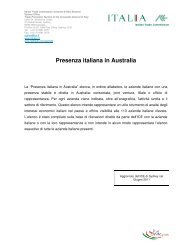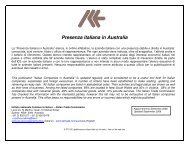Price Determination in the Australian Food Industry A Report
Price Determination in the Australian Food Industry A Report
Price Determination in the Australian Food Industry A Report
Create successful ePaper yourself
Turn your PDF publications into a flip-book with our unique Google optimized e-Paper software.
Figure 87. Oils and fats, supply cha<strong>in</strong> map<br />
Farmer<br />
Primary<br />
Process<br />
Secondary<br />
Process<br />
Market Logistics<br />
Retail<br />
Brand Ownership/ Management<br />
Export Markets<br />
Farmer<br />
Crusher<br />
Ref<strong>in</strong>er/<br />
Marketer<br />
Cha<strong>in</strong> Retailers<br />
Consumer<br />
harvest/transport/<br />
store<br />
• Around 2.5–3<br />
million tonnes of<br />
oilseeds produced<br />
annually.<br />
• Canola w<strong>in</strong>ter crop<br />
grown <strong>in</strong> sou<strong>the</strong>rn<br />
and western<br />
Australia.<br />
• O<strong>the</strong>r oilseeds<br />
mostly summer<br />
grown and<br />
predom<strong>in</strong>antly <strong>in</strong><br />
nor<strong>the</strong>rn New South<br />
Wales and<br />
Queensland.<br />
• Ma<strong>in</strong> drivers of price<br />
are global<br />
commodity prices.<br />
• There are seven crushers,<br />
however, one has 85%<br />
market share. There are<br />
two players servic<strong>in</strong>g <strong>the</strong><br />
ma<strong>in</strong>stream ref<strong>in</strong>ers and a<br />
number of smaller ones<br />
produc<strong>in</strong>g niche<br />
commodities or servic<strong>in</strong>g<br />
non-grocery markets.<br />
• Yield varies by seed type –<br />
high oil varieties have<br />
around 40% oil: 60% meal<br />
and low oil varieties have<br />
20% oil:80% meal.<br />
• However, oil is <strong>in</strong> most<br />
cases <strong>the</strong> economic driver.<br />
Wholesalers<br />
• There are five ref<strong>in</strong>ers <strong>in</strong><br />
Australia, although two have<br />
90% of capacity. These players<br />
– Goodman Fielder and<br />
Unilever – are <strong>the</strong> predom<strong>in</strong>ant<br />
suppliers to <strong>the</strong> retail market<br />
along with imports.<br />
• These players purchase crude<br />
oil from crushers and recover<br />
around 95%.<br />
O<strong>the</strong>r Retailers<br />
<strong>Food</strong> Service/<br />
Commercial<br />
• There is little sale of<br />
consumer pack oil <strong>in</strong>to food<br />
service, yet sales of<br />
spreads <strong>in</strong>to this sector<br />
<strong>in</strong>cludes retail pack sizes<br />
for ease of use <strong>in</strong> sandwich<br />
preparation.<br />
• Major supermarkets<br />
account for majority of<br />
retail sales.<br />
• Branded product is about<br />
50% of retail pack sales of<br />
oil.<br />
OILS AND FATS RETAIL MARKET<br />
The <strong>Australian</strong> retail market<br />
<strong>Price</strong> <strong>Determ<strong>in</strong>ation</strong> <strong>in</strong> <strong>the</strong> <strong>Australian</strong> <strong>Food</strong> <strong>Industry</strong> A <strong>Report</strong><br />
The margar<strong>in</strong>e segment has been undergo<strong>in</strong>g a period of decl<strong>in</strong>e while <strong>the</strong> cook<strong>in</strong>g oil segment<br />
has been grow<strong>in</strong>g, although this is primarily <strong>in</strong> <strong>the</strong> olive oil segment.<br />
Value and volume of grocery sales of spreads and oils<br />
Margar<strong>in</strong>e Blends Butter Cook<strong>in</strong>g Oil<br />
2000 2002 2002 2002<br />
Value $m 266 63 61 218<br />
Volume 83,193t 14,221t 14,402t 527 M litres<br />
Note: <strong>the</strong> above figures only represent <strong>the</strong> grocery trade of major supermarket groups and do<br />
not capture sales through <strong>in</strong>dependents, convenience stores and food service.<br />
For example, total margar<strong>in</strong>e production is around 150,000 tonnes.<br />
Source: <strong>Australian</strong> Oilseeds Federation<br />
The retail yellow spreads market is decl<strong>in</strong><strong>in</strong>g at around 3 per cent per annum. With<strong>in</strong> <strong>the</strong> yellow<br />
spreads segment, butter is see<strong>in</strong>g a rise <strong>in</strong> popularity. While margar<strong>in</strong>e use is decl<strong>in</strong><strong>in</strong>g, it still<br />
accounts for 66 per cent of <strong>the</strong> total spreads market. Generics have won a greater share of <strong>the</strong><br />
market as consumers recognise that <strong>the</strong> quality is comparable. Polyunsaturated margar<strong>in</strong>es<br />
cont<strong>in</strong>ue to dom<strong>in</strong>ate <strong>the</strong> segment with 63.4 per cent of margar<strong>in</strong>e sales. Monounsaturated<br />
margar<strong>in</strong>es account for 29.2 per cent of margar<strong>in</strong>e sales.<br />
While <strong>the</strong> number of households consum<strong>in</strong>g margar<strong>in</strong>e rema<strong>in</strong>s constant, <strong>the</strong> oil content of<br />
vegetable oil spreads has dropped with <strong>the</strong> move to low-fat products and <strong>the</strong> use of o<strong>the</strong>r<br />
<strong>in</strong>gredients (<strong>in</strong>clud<strong>in</strong>g dairy fat <strong>in</strong> blends). Spreads offer<strong>in</strong>g unique position<strong>in</strong>g – for example,<br />
cholesterol lower<strong>in</strong>g – and olive oil have been <strong>in</strong>troduced <strong>in</strong> an attempt to re<strong>in</strong>vigorate <strong>the</strong> market.<br />
82







